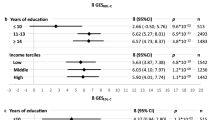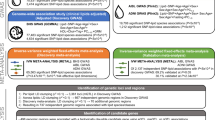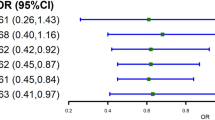Abstract
Genome-wide association studies (GWASs) have identified polymorphic loci associated with coronary artery disease (CAD) risk factors (i.e. serum lipids) in adult populations (42–69 y). We hypothesized that younger populations would show a greater relative genetic component due to fewer confounding variables. We examined the influence of 20 GWAS loci associated with serum lipids and insulin metabolism, in a university student cohort (n = 548; mean age = 24 y), and replicated statistically associated results in a second study cohort of primary school students (n = 810, mean age = 11.5 y). Nineteen loci showed no relationship with studied risk factors in young adults. However, the ancestral allele of the rs646776 (SORT1) locus was strongly associated with increased LDL (C) in young adults [TT: 97.6 ± 1.0 mg/dL (n = 345) versus CT/CC: 87.3 ± 1.0 mg/dL (n = 203); p = 3 × 10×6] and children [TT: 94.0 ± 1.3 mg/dL (n = 551) versus CT/CC: 84.7 ± 1.4 mg/dL (n = 259); p = 4 × 10×6]. This locus is responsible for 3.6% of population variance in young adults and 2.5% of population variance in children. The effect size of the SORT1 locus is considerably higher in young populations (2.5–4.1%) compared with older subjects (1%).
Similar content being viewed by others
Log in or create a free account to read this content
Gain free access to this article, as well as selected content from this journal and more on nature.com
or
Abbreviations
- CAD:
-
coronary artery disease
- CHIP:
-
Cardiovascular Health Intervention Program
- FAMUSS:
-
Functional Polymorphism Associated with Human Muscle Size and Strength
- GWAS:
-
genome-wide association study
- HOMA:
-
homoeostasis model assessment
- T2DM:
-
type II diabetes mellitus
- SNP:
-
single-nucleotide polymorphism
- STRRIDE:
-
Studies of a Targeted Risk Reduction Intervention through Defined Exercise
REFERENCES
McCarthy MI, Zeggini E 2009 Genome-wide association studies in type 2 diabetes. Curr Diab Rep 9: 164–171
Ioannidis JP 2009 Prediction of cardiovascular disease outcomes and established cardiovascular risk factors by genome-wide association markers. Circ Cardiovasc Genet 2: 7–15
Walley AJ, Asher JE, Froguel P 2009 The genetic contribution to non-syndromic human obesity. Nat Rev Genet 10: 431–442
Ehret GB 2010 Genome-wide association studies: contribution of genomics to understanding blood pressure and essential hypertension. Curr Hypertens Rep 12: 17–25
Kathiresan S, Willer CJ, Peloso GM, Demissie S, Musunuru K, Schadt EE, Kaplan L, Bennett D, Li Y, Tanaka T, Voight BF, Bonnycastle LL, Jackson AU, Crawford G, Surti A, Guiducci C, Burtt NP, Parish S, Clarke R, Zelenika D, Kubalanza KA, Morken MA, Scott LJ, Stringham HM, Galan P, Swift AJ, Kuusisto J, Bergman RN, Sundvall J, Laakso M, Ferrucci L, Scheet P, Sanna S, Uda M, Yang Q, Lunetta KL, Dupuis J, de Bakker PI, O'Donnell CJ, Chambers JC, Kooner JS, Hercberg S, Meneton P, Lakatta EG, Scuteri A, Schlessinger D, Tuomilehto J, Collins FS, Groop L, Altshuler D, Collins R, Lathrop GM, Melander O, Salomaa V, Peltonen L, Orho-Melander M, Ordovas JM, Boehnke M, Abecasis GR, Mohlke KL, Cupples LA 2009 Common variants at 30 loci contribute to polygenic dyslipidemia. Nat Genet 41: 56–65
Beck-Nielsen H, Vaag A, Poulsen P, Gaster M 2003 Metabolic and genetic influence on glucose metabolism in type 2 diabetic subjects—experiences from relatives and twin studies. Best Pract Res Clin Endocrinol Metab 17: 445–467
Jakobsdottir J, Gorin MB, Conley YP, Ferrell RE, Weeks DE 2009 Interpretation of genetic association studies: markers with replicated highly significant odds ratios may be poor classifiers. PLoS Genet 5: e1000337
Kathiresan S, Melander O, Anevski D, Guiducci C, Burtt NP, Roos C, Hirschhorn JN, Berglund G, Hedblad B, Groop L, Altshuler DM, Newton-Cheh C, Orho-Melander M 2008 Polymorphisms associated with cholesterol and risk of cardiovascular events. N Engl J Med 358: 1240–1249
Kathiresan S, Melander O, Guiducci C, Surti A, Burtt NP, Rieder MJ, Cooper GM, Roos C, Voight BF, Havulinna AS, Wahlstrand B, Hedner T, Corella D, Tai ES, Ordovas JM, Berglund G, Vartiainen E, Jousilahti P, Hedblad B, Taskinen MR, Newton-Cheh C, Salomaa V, Peltonen L, Groop L, Altshuler DM, Orho-Melander M 2008 Six new loci associated with blood low-density lipoprotein cholesterol, high-density lipoprotein cholesterol or triglycerides in humans. Nat Genet 40: 189–197
Erdmann J, Grosshennig A, Braund PS, Konig IR, Hengstenberg C, Hall AS, Linsel-Nitschke P, Kathiresan S, Wright B, Tregouet DA, Cambien F, Bruse P, Aherrahrou Z, Wagner AK, Stark K, Schwartz SM, Salomaa V, Elosua R, Melander O, Voight BF, O'Donnell CJ, Peltonen L, Siscovick DS, Altshuler D, Merlini PA, Peyvandi F, Bernardinelli L, Ardissino D, Schillert A, Blankenberg S, Zeller T, Wild P, Schwarz DF, Tiret L, Perret C, Schreiber S, El Mokhtari NE, Schafer A, Marz W, Renner W, Bugert P, Kluter H, Schrezenmeir J, Rubin D, Ball SG, Balmforth AJ, Wichmann HE, Meitinger T, Fischer M, Meisinger C, Baumert J, Peters A, Ouwehand WH, Deloukas P, Thompson JR, Ziegler A, Samani NJ, Schunkert H 2009 New susceptibility locus for coronary artery disease on chromosome 3q22.3. Nat Genet 41: 280–282
Ingelsson E, Schaefer EJ, Contois JH, McNamara JR, Sullivan L, Keyes MJ, Pencina MJ, Schoonmaker C, Wilson PW, D'Agostino RB, Vasan RS 2007 Clinical utility of different lipid measures for prediction of coronary heart disease in men and women. JAMA 298: 776–785
Thompson PD, Moyna N, Seip R, Price T, Clarkson P, Angelopoulos T, Gordon P, Pescatello L, Visich P, Zoeller R, Devaney JM, Gordish H, Bilbie S, Hoffman EP 2004 Functional polymorphisms associated with human muscle size and strength. Med Sci Sports Exerc 36: 1132–1139
Keskin M, Kurtoglu S, Kendirci M, Atabek ME, Yazici C 2005 Homeostasis model assessment is more reliable than the fasting glucose/insulin ratio and quantitative insulin sensitivity check index for assessing insulin resistance among obese children and adolescents. Pediatrics 115: e500–e503
Orkunoglu-Suer FE, Gordish-Dressman H, Clarkson PM, Thompson PD, Angelopoulos TJ, Gordon PM, Moyna NM, Pescatello LS, Visich PS, Zoeller RF, Harmon B, Seip RL, Hoffman EP, Devaney JM 2008 INSIG2 gene polymorphism is associated with increased subcutaneous fat in women and poor response to resistance training in men. BMC Med Genet 9: 117
Lee JM, Gebremariam A, Card-Higginson P, Shaw JL, Thompson JW, Davis MM 2009 Poor performance of body mass index as a marker for hypercholesterolemia in children and adolescents. Arch Pediatr Adolesc Med 163: 716–723
Holvoet P, Kritchevsky SB, Tracy RP, Mertens A, Rubin SM, Butler J, Goodpaster B, Harris TB 2004 The metabolic syndrome, circulating oxidized LDL, and risk of myocardial infarction in well-functioning elderly people in the health, aging, and body composition cohort. Diabetes 53: 1068–1073
Holvoet P, Lee DH, Steffes M, Gross M, Jacobs DR Jr 2008 Association between circulating oxidized low-density lipoprotein and incidence of the metabolic syndrome. JAMA 299: 2287–2293
Kopprasch S, Pietzsch J, Kuhlisch E, Fuecker K, Temelkova-Kurktschiev T, Hanefeld M, Kuhne H, Julius U, Graessler J 2002 In vivo evidence for increased oxidation of circulating LDL in impaired glucose tolerance. Diabetes 51: 3102–3106
Lapointe A, Couillard C, Piche ME, Weisnagel SJ, Bergeron J, Nadeau A, Lemieux S 2007 Circulating oxidized LDL is associated with parameters of the metabolic syndrome in postmenopausal women. Atherosclerosis 191: 362–368
Kavey RE, Daniels SR, Lauer RM, Atkins DL, Hayman LL, Taubert K 2003 American Heart Association guidelines for primary prevention of atherosclerotic cardiovascular disease beginning in childhood. Circulation 107: 1562–1566
Slentz CA, Aiken LB, Houmard JA, Bales CW, Johnson JL, Tanner CJ, Duscha BD, Kraus WE 2005 Inactivity, exercise, and visceral fat. STRRIDE: a randomized, controlled study of exercise intensity and amount. J Appl Physiol 99: 1613–1618
Ridderstråle M, Groop L 2009 Genetic dissection of type 2 diabetes. Mol Cell Endocrinol 297: 10–17
Musunuru K, Strong A, Frank-Kamenetsky M, Lee NE, Ahfeldt T, Sachs KV, Li X, Li H, Kuperwasser N, Ruda VM, Pirruccello JP, Muchmore B, Prokunina-Olsson L, Hall JL, Schadt EE, Morales CR, Lund-Katz S, Phillips MC, Wong J, Cantley W, Racie T, Ejebe KG, Orho-Melander M, Melander O, Koteliansky V, Fitzgerald K, Krauss RM, Cowan CA, Kathiresan S, Rader DJ 2010 From noncoding variant to phenotype via SORT1 at the 1p13 cholesterol locus. Nature 466: 714–719
Köttgen A, Hwang SJ, Rampersaud E, Coresh J, North KE, Pankow JS, Meigs JB, Florez JC, Parsa A, Levy D, Boerwinkle E, Shuldiner AR, Fox CS, Kao WH 2008 TCF7L2 variants associate with CKD progression and renal function in population-based cohorts. J Am Soc Nephrol 19: 1989–1999
Author information
Authors and Affiliations
Corresponding author
Additional information
Supported by NIAMS—5R01AR055100-07 (FAMUSS), NIDDK—1R01DK081559-01A1 (STRRIDE), and Owosso Memorial Health Care System (CHIP).
Rights and permissions
About this article
Cite this article
Devaney, J., Thompson, P., Visich, P. et al. The 1p13.3 LDL (C)-Associated Locus Shows Large Effect Sizes in Young Populations. Pediatr Res 69, 538–543 (2011). https://doi.org/10.1203/PDR.0b013e3182139227
Received:
Accepted:
Issue date:
DOI: https://doi.org/10.1203/PDR.0b013e3182139227
This article is cited by
-
Sortilin, Encoded by the Cardiovascular Risk Gene SORT1, and Its Suggested Functions in Cardiovascular Disease
Current Atherosclerosis Reports (2015)
-
Principal component analysis reveals gender-specific predictors of cardiometabolic risk in 6th graders
Cardiovascular Diabetology (2012)



